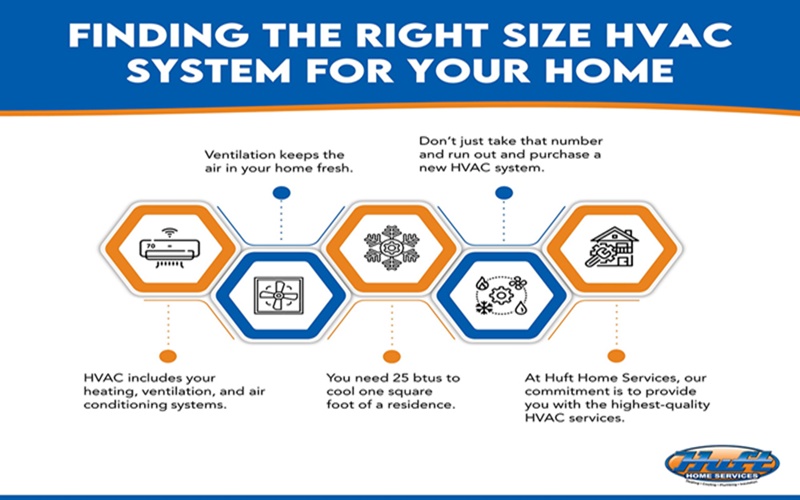When it comes to maintaining the perfect indoor climate, selecting the right size HVAC system is critical. An HVAC (Heating, Ventilation, and Air Conditioning) system that is too large or too small can lead to inefficiencies, increased energy consumption, and uncomfortable living conditions. Understanding how to calculate the correct HVAC system size for your home ensures that your system operates efficiently, saving you money and maintaining comfort year-round.

Why Choosing the Right HVAC System Size Matters
Before diving into the details of selecting an HVAC system, it is essential to understand why the correct size is so important. HVAC system sizing plays a significant role in ensuring optimal performance, efficiency, and comfort in your home. A unit that is too small will struggle to maintain your desired indoor temperature, leading to increased energy consumption, premature wear, and higher utility bills. On the other hand, an oversized unit will cycle on and off too frequently, resulting in poor humidity control and a less comfortable environment.
Proper sizing is the key to ensuring that your HVAC system works as intended, providing consistent temperature control while keeping energy usage in check.
Factors to Consider When Sizing an HVAC System
Several factors come into play when determining the appropriate size for your HVAC system. Let’s explore these key considerations:
1. Square Footage of Your Home
The first step in calculating the right HVAC system size is knowing the square footage of your home. The general rule of thumb is that one ton of cooling capacity is required for every 600 to 1,000 square feet of living space. However, this is a basic estimate, and the calculation needs to take into account several other variables.
Calculating HVAC Size Based on Square Footage
For instance, if you have a home with 2,500 square feet of space, you would typically need a 2.5 to 4-ton HVAC unit. This estimate, while useful, can be adjusted based on factors like insulation, number of windows, and more.
2. Home Insulation and Windows
Insulation and windows have a significant impact on the efficiency of your HVAC system. Well-insulated homes retain heat and cool air more effectively, allowing the HVAC system to work less hard to maintain the desired temperature. Homes with poor insulation or numerous windows that let in heat or cold will require a larger HVAC system to compensate for energy losses.
3. Local Climate
The climate in your region plays a significant role in determining the size of the HVAC system. Hotter climates generally require more cooling capacity, while colder climates need more heating power. If you live in an area with extreme seasonal temperatures, it is essential to factor in the average temperature fluctuations and the type of heating or cooling system you need.
4. Ceiling Height
Standard ceiling heights are typically around 8 feet, but homes with vaulted or higher ceilings need to account for more air volume. Rooms with higher ceilings require more energy to cool or heat, so you may need a slightly larger HVAC system.
5. Number of Occupants
The number of people living in the home directly influences the load on your HVAC system. More people generate more heat, requiring the system to work harder to cool the air. If you have a large family or often entertain guests, you may need a higher-capacity system.
6. Number of Appliances and Electronics
Large appliances, lighting, and electronics in your home can all add to the heat load. Appliances such as ovens, refrigerators, and dishwashers generate heat while running, and electronics like computers and televisions also contribute. These factors should be considered when determining the cooling capacity of your HVAC system.
How to Calculate the Right HVAC Size for Your Home
Now that we’ve reviewed the primary factors influencing HVAC size, let’s explore how to calculate the BTU (British Thermal Units) rating needed for your home. The BTU rating determines the capacity of your system to heat or cool your home. The more BTUs your HVAC system can generate, the more space it can heat or cool.
Step-by-Step Guide to Calculating Your HVAC Size
1. Calculate the square footage of your home by measuring the length and width of each room and multiplying them together.
2. Multiply the square footage by a factor of 25. This gives you an estimate of the number of BTUs needed for basic cooling or heating.For example, a 2,000 square foot home requires 50,000 BTUs (2,000 x 25).
3. Adjust for factors like insulation, ceiling height, and windows. Increase or decrease the BTU estimate based on the size and quality of insulation, window placement, and the overall construction of the house.
4. Consider regional climate adjustments. For example, if you live in an extremely hot climate, you may need 20% more cooling capacity.
Using Online HVAC Sizing Calculators
Many websites offer free HVAC sizing calculators to make this process easier. By entering the basic information about your home, these tools can provide you with a more accurate estimate of the size HVAC system you need. However, keep in mind that these calculators might not account for every specific factor. For a precise assessment, it is always a good idea to consult a professional.
Professional Load Calculation for HVAC Systems
While DIY methods can provide a rough estimate, the most accurate way to determine the correct size for your HVAC system is through a Manual J Load Calculation. This method is a comprehensive analysis that takes into account all aspects of your home, including insulation levels, windows, doors, and even the direction your home faces relative to the sun.
A professional HVAC contractor can perform a Manual J Load Calculation to give you the most accurate estimate for your HVAC system. This will ensure that your system is perfectly sized, reducing energy waste and improving comfort.
Common Mistakes When Sizing an HVAC System
Choosing the right HVAC system size is critical to achieving maximum efficiency. However, there are several common mistakes homeowners make when selecting a unit:
1. Choosing the Wrong Unit Size: Whether it’s too large or too small, incorrect sizing can result in higher energy bills and an uncomfortable living environment.
2. Overlooking Insulation: Poor insulation can significantly affect the energy efficiency of your system, requiring a larger unit to compensate.
3. Neglecting Maintenance: Regular HVAC system maintenance is crucial to ensure optimal performance. Neglecting to clean or replace filters, or failing to have the system serviced, can reduce the lifespan and efficiency of your unit.
4. Not Considering Future Needs: If you’re planning on expanding your home or adding more appliances, consider how these factors will affect your HVAC needs in the future.
Conclusion
In conclusion, choosing the right HVAC system size is essential for achieving optimal comfort and energy efficiency in your home. By considering factors such as the square footage, insulation, number of occupants, and local climate, you can determine the appropriate size unit for your needs. While basic calculations can give you a good starting point, consulting with a professional for a detailed load calculation ensures that your system is sized correctly.
